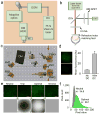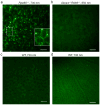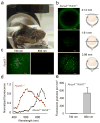Noninvasive two-photon microscopy imaging of mouse retina and retinal pigment epithelium through the pupil of the eye
- PMID: 24952647
- PMCID: PMC4087080
- DOI: 10.1038/nm.3590
Noninvasive two-photon microscopy imaging of mouse retina and retinal pigment epithelium through the pupil of the eye
Abstract
Two-photon excitation microscopy can image retinal molecular processes in vivo. Intrinsically fluorescent retinyl esters in subcellular structures called retinosomes are an integral part of the visual chromophore regeneration pathway. Fluorescent condensation products of all-trans-retinal accumulate in the eye with age and are also associated with age-related macular degeneration (AMD). Here, we report repetitive, dynamic imaging of these compounds in live mice through the pupil of the eye. By leveraging advanced adaptive optics, we developed a data acquisition algorithm that permitted the identification of retinosomes and condensation products in the retinal pigment epithelium by their characteristic localization, spectral properties and absence in genetically modified or drug-treated mice. This imaging approach has the potential to detect early molecular changes in retinoid metabolism that trigger light- and AMD-induced retinal defects and to assess the effectiveness of treatments for these conditions.
Conflict of interest statement
Competing Financial Interests: G.P. and Z.D. are employees of Polgenix. K.P. is CSO at Polgenix Inc. K.P. is an inventor of the U.S. Patent No. 7,706,863 and U.S. Patent No. 8,346,345 whose value may be affected by this publication. N.S.A and M.G., report no conflict of interest. The J.J.H and D.R.W. laboratories received support from Polgenix Inc.
Figures




Similar articles
-
Noninvasive multiphoton fluorescence microscopy resolves retinol and retinal condensation products in mouse eyes.Nat Med. 2010 Dec;16(12):1444-9. doi: 10.1038/nm.2260. Epub 2010 Nov 14. Nat Med. 2010. PMID: 21076393 Free PMC article.
-
Noninvasive Two-Photon Microscopy Imaging of Mouse Retina and Retinal Pigment Epithelium.Methods Mol Biol. 2019;1834:333-343. doi: 10.1007/978-1-4939-8669-9_21. Methods Mol Biol. 2019. PMID: 30324453 Free PMC article.
-
Retinyl ester storage particles (retinosomes) from the retinal pigmented epithelium resemble lipid droplets in other tissues.J Biol Chem. 2011 May 13;286(19):17248-58. doi: 10.1074/jbc.M110.195198. Epub 2011 Mar 25. J Biol Chem. 2011. PMID: 21454509 Free PMC article.
-
From mouse to human: Accessing the biochemistry of vision in vivo by two-photon excitation.Prog Retin Eye Res. 2023 Mar;93:101170. doi: 10.1016/j.preteyeres.2023.101170. Epub 2023 Feb 12. Prog Retin Eye Res. 2023. PMID: 36787681 Free PMC article. Review.
-
DNA damage response and autophagy in the degeneration of retinal pigment epithelial cells-Implications for age-related macular degeneration (AMD).Ageing Res Rev. 2017 Jul;36:64-77. doi: 10.1016/j.arr.2017.03.006. Epub 2017 Mar 27. Ageing Res Rev. 2017. PMID: 28351686 Review.
Cited by
-
High-resolution contrast-enhanced optical coherence tomography in mice retinae.J Biomed Opt. 2016 Jun 1;21(6):66002. doi: 10.1117/1.JBO.21.6.066002. J Biomed Opt. 2016. PMID: 27264492 Free PMC article.
-
Evaluation of the Returned Electromagnetic Signal from Retro-reflectors in Turbid Media.Sci Rep. 2019 Apr 25;9(1):6550. doi: 10.1038/s41598-019-43059-z. Sci Rep. 2019. PMID: 31024049 Free PMC article.
-
Transmissive Single-Pixel Microscopic Imaging through Scattering Media.Sensors (Basel). 2021 Apr 13;21(8):2721. doi: 10.3390/s21082721. Sensors (Basel). 2021. PMID: 33924285 Free PMC article.
-
In vivo imaging of axonal transport of mitochondria in the diseased and aged mammalian CNS.Proc Natl Acad Sci U S A. 2015 Aug 18;112(33):10515-20. doi: 10.1073/pnas.1509879112. Epub 2015 Aug 3. Proc Natl Acad Sci U S A. 2015. PMID: 26240337 Free PMC article.
-
Retinal safety evaluation of two-photon laser scanning in rats.Biomed Opt Express. 2019 Jun 11;10(7):3217-3231. doi: 10.1364/BOE.10.003217. eCollection 2019 Jul 1. Biomed Opt Express. 2019. PMID: 31467775 Free PMC article.
References
-
- Helmchen F, Denk W. Deep tissue two-photon microscopy. Nat Methods. 2005;2:932–940. - PubMed
-
- Boettner EA, Wolter JR. Transmission of the oculer media. Invest Ophthalmol Vis Sci. 1962;1:776–183.
Publication types
MeSH terms
Grants and funding
- P30 EY011373/EY/NEI NIH HHS/United States
- R01EY008061/EY/NEI NIH HHS/United States
- R24EY021126/EY/NEI NIH HHS/United States
- R01 EY008061/EY/NEI NIH HHS/United States
- 5T32DK007319/DK/NIDDK NIH HHS/United States
- R44 AG043645/AG/NIA NIH HHS/United States
- R44AG043645/AG/NIA NIH HHS/United States
- R01 EY009339/EY/NEI NIH HHS/United States
- T32 EY007157/EY/NEI NIH HHS/United States
- P30EY11373/EY/NEI NIH HHS/United States
- 5T32EY007157/EY/NEI NIH HHS/United States
- R01EY009339/EY/NEI NIH HHS/United States
- T32 DK007319/DK/NIDDK NIH HHS/United States
- R24 EY021126/EY/NEI NIH HHS/United States
LinkOut - more resources
Full Text Sources
Other Literature Sources
Molecular Biology Databases

